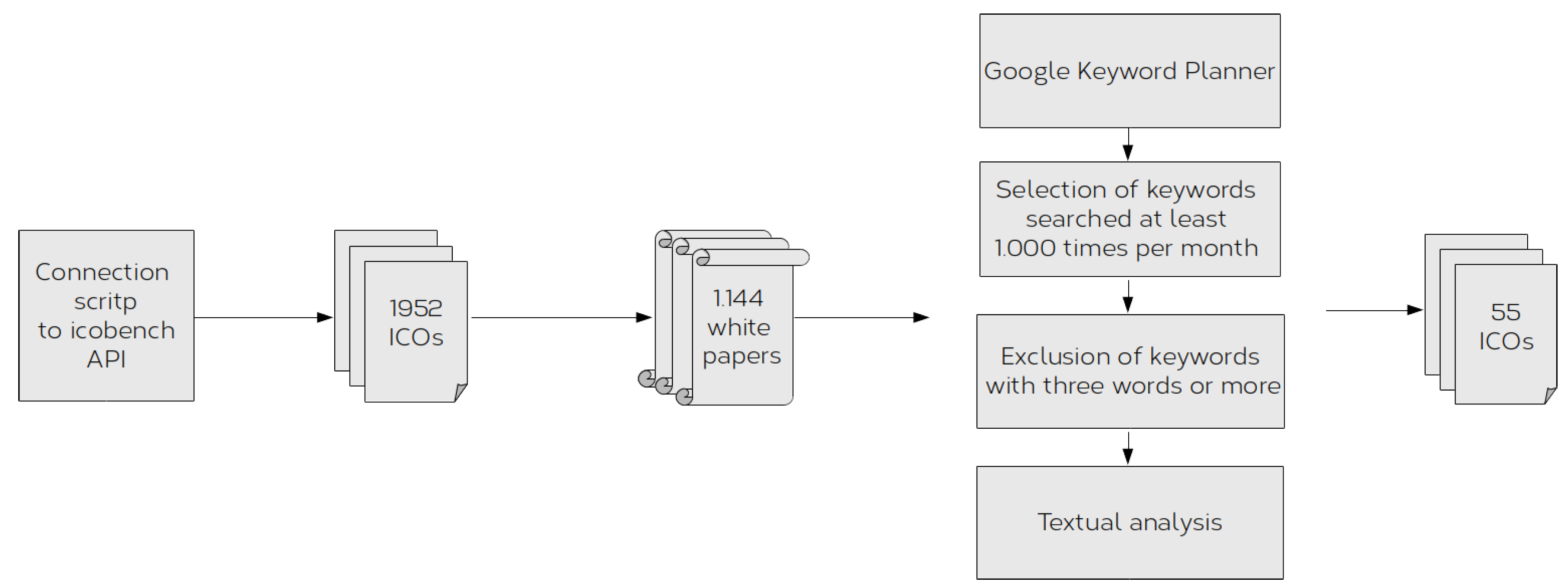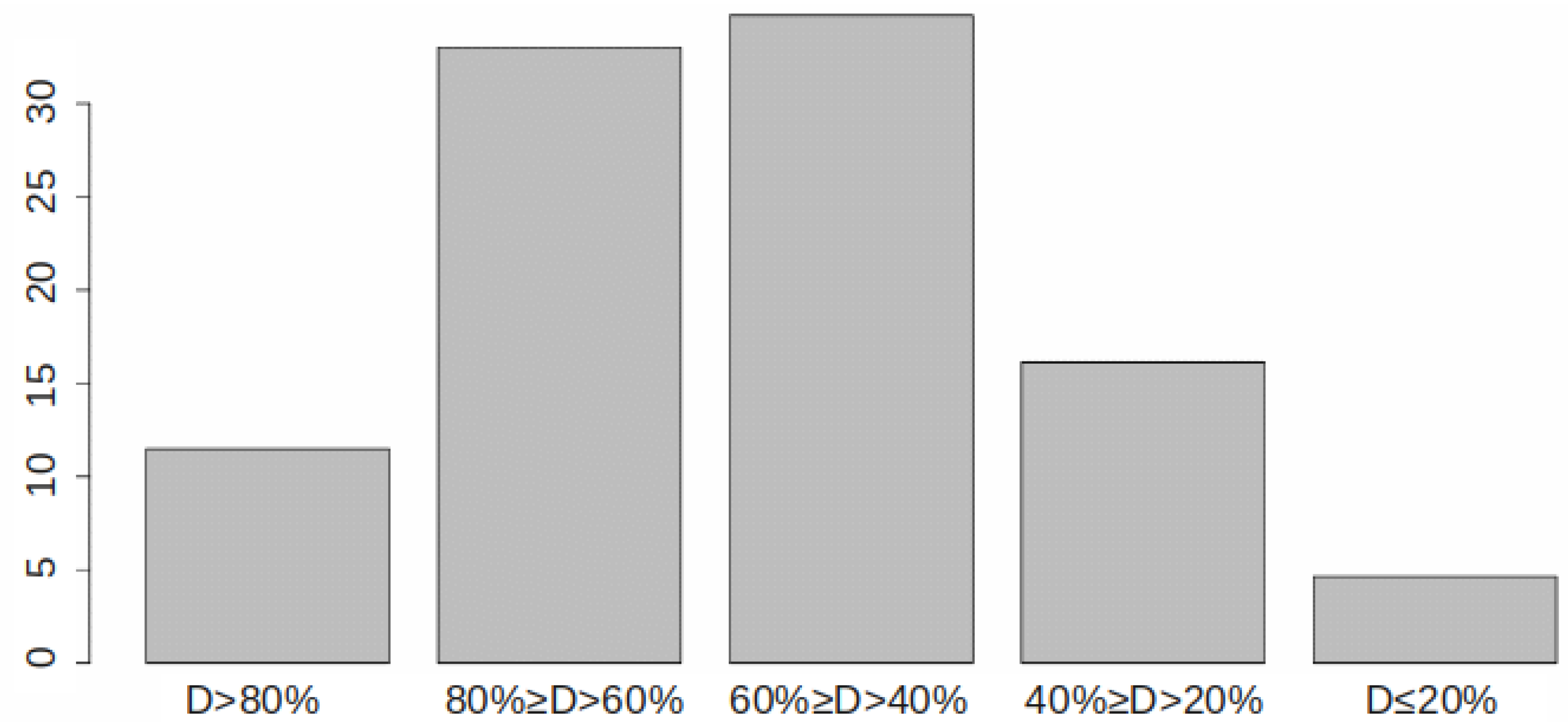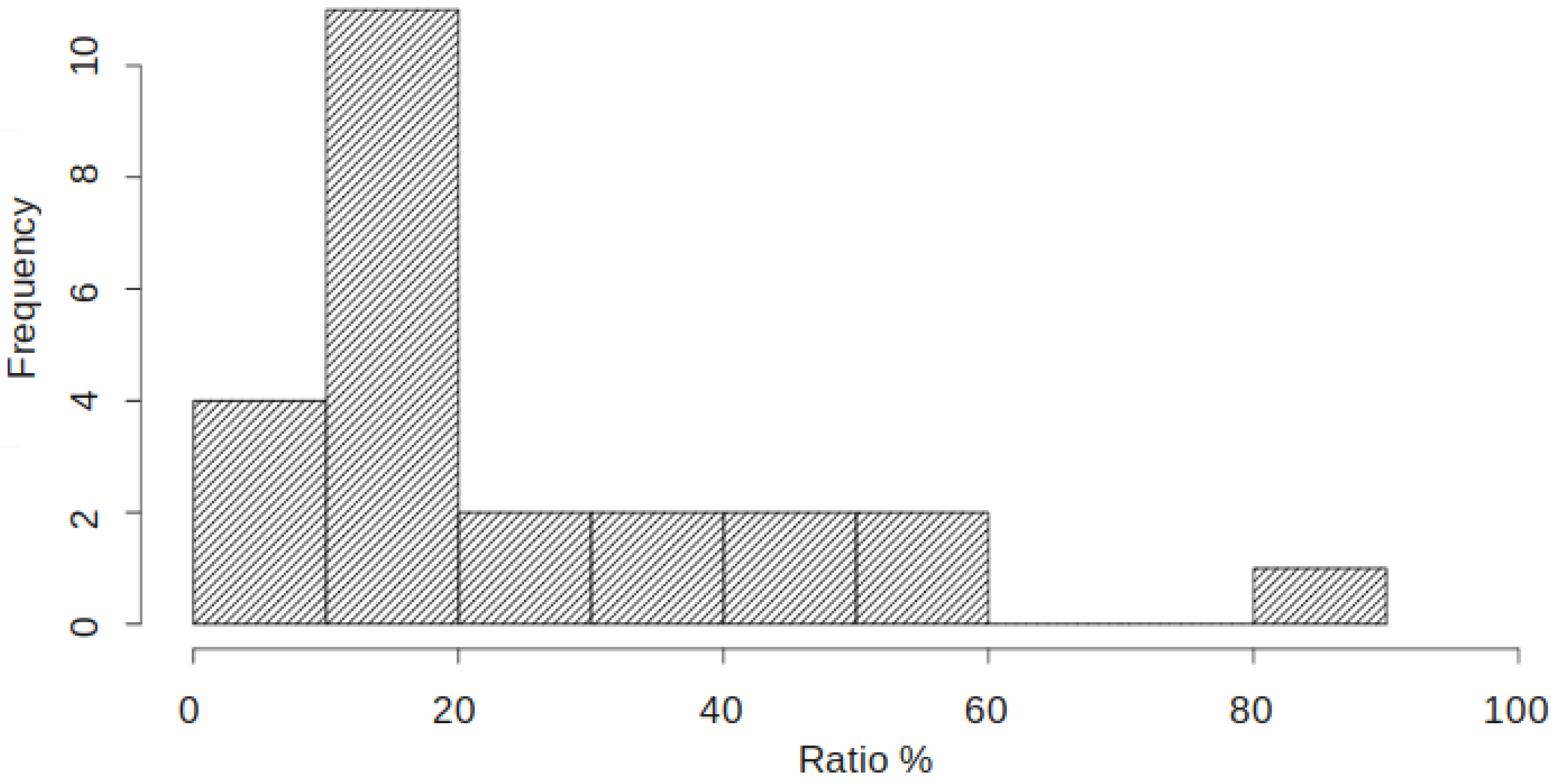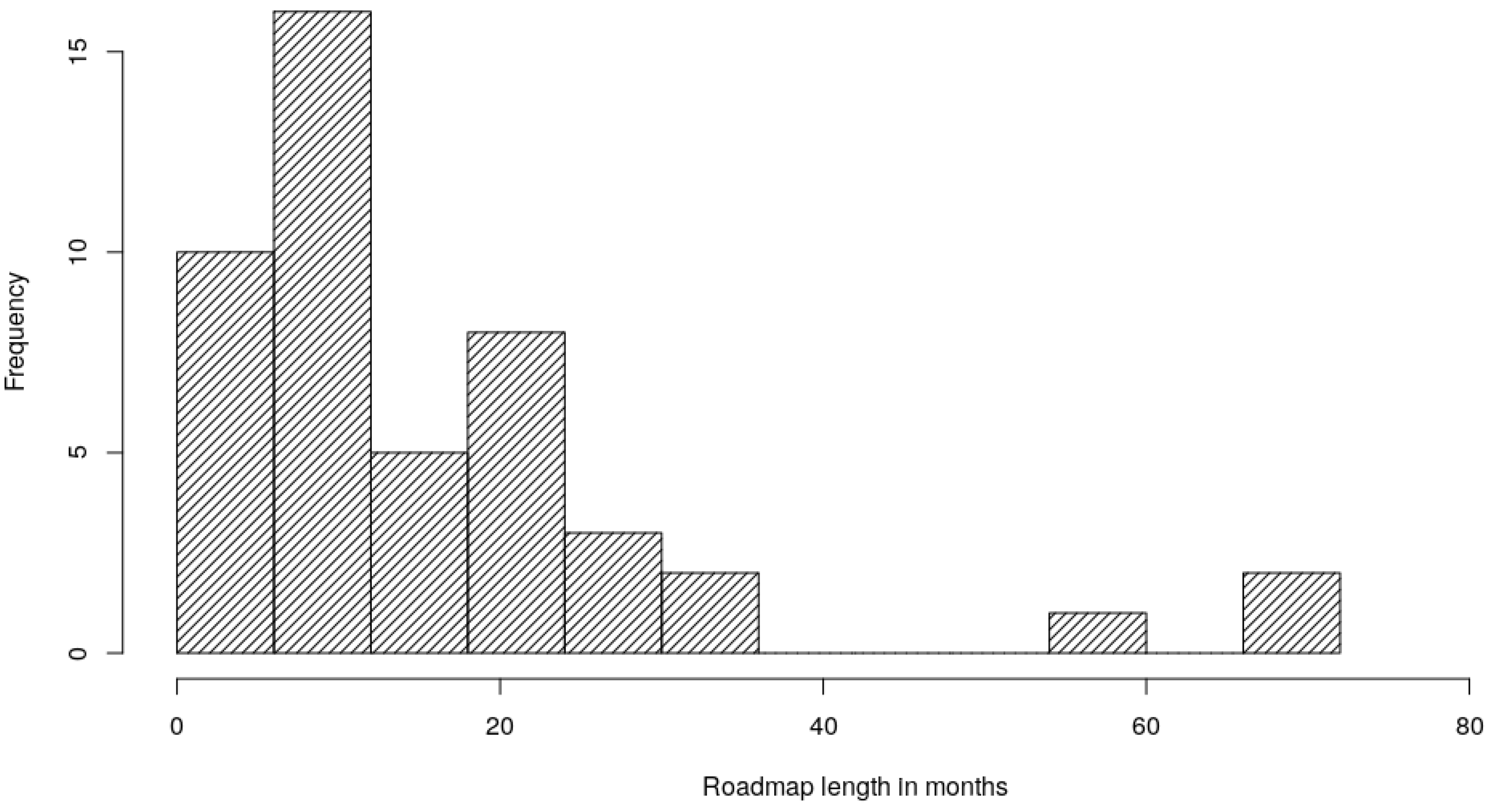Initial Coin Offerings and Agile Practices
Abstract
1. Introduction
- Understanding the main characteristics of ICOs, investigating software engineering activities related to ICOs, recognizing the ICOs developed using Agile methods, and making a comparison between the characteristics of Agile and not Agile ICOs.
- Providing a deep analysis of the Agile ICOs in terms of their project planning, software development, and source codes.
2. Related Work
3. Research Method
3.1. Data Collection
3.1.1. Step 1
3.1.2. Step 2
- We used the Google Keyword Planner tool and we obtained all the keywords associated with the main keyword: “Agile methodology”. In this way we obtained a total of 700 keywords.
- We selected all keywords that have an average monthly number of searches on Google above 1000.
- We included keywords consisting of single words (for example “scrum”) and their specifications covering at most another word. For example, we selected the keyword “scrum programming” and we excluded the keyword “scrum programming development” because it is implicitly included in the previous one.
3.2. Analysis Setup
4. Data Analysis
4.1. Analysis of ICOs Teams
Team Size and Composition
4.2. Gender Heterogeneity
4.3. ICO Rating
4.4. Social Media and Tools
4.5. Financial Aspects
Ico Market Capitalization
5. Analysis of Agile ICOs Projects
5.1. Roadmap and ICO State
- only 18 ICOs present a roadmap longer than one year;
- the longest roadmap extends 72 months after the end of the ICO;
- the average duration of roadmaps is 16 months after the ICO end;
- in 2 cases, the roadmap is concluded with the closing of the ICO.
- The roadmap must be oriented towards objectives much more than towards the features be developed, so that everyone involved can understand the evolution of the product.
- The creation of Agile roadmaps requires continuous communication within the team, and with investors. It also needs to harness the effort of all the parts involved.
- In an ICO, it is essential to respond adequately to the needs of investors. Responding promptly to customers’ needs through continuous dialogue is one of the essential characteristics of the Agile approach. The roadmap should therefore take into account all investors’ feedback for possible improvements. The new ideas, evaluated through a score, must be included in a future release backlog. The ideas of investors and customers should therefore guide the definition of future priorities.
- The roadmap should be changed quite frequently (from one to three months) in order to adapt the plans with the obtained feedback. Updating the roadmap can help a project to face changes without diverting attention from long-term goals.
5.2. Software Development
- 36 ICOs have a software project publicly available on the Github platform.
- 12 of the remaining ICOs published in the Ethereum blockchain explorer Etherscan (https://etherscan.io/) the solidity code of the smart contract used to implement the token selling.
- 7 ICOs do not have a publicly available software project nor provide any smart contract solidity file.
5.2.1. Smart Contract Code Metrics
5.2.2. Testing
6. Discussion
7. Conclusions
Author Contributions
Funding
Acknowledgments
Conflicts of Interest
References
- Nakamoto, S. Bitcoin: A Peer-to-Peer Electronic Cash System. Available online: https://bitcoin.org/en/bitcoin-paper (accessed on 20 October 2018).
- Swan, M. Blockchain: Blueprint for a New Economy; O’Reilly Media, Inc.: Sebastopol, CA, USA, 2015. [Google Scholar]
- Kosba, A.; Miller, A.; Shi, E.; Wen, Z.; Papamanthou, C. Hawk: The blockchain model of cryptography and privacy-preserving smart contracts. In Proceedings of the 2016 IEEE Symposium on Security and Privacy (SP), San Jose, CA, USA, 22–26 May 2016; pp. 839–858. [Google Scholar]
- Buterin, V. A nExt-Generation Smart Contract and Decentralized Application Platform. Available online: http://blockchainlab.com/pdf/Ethereumwhitepaper-anextgenerationsmartcontractanddecentralizedapplicationplatform-vitalik-buterin.pdf (accessed on 20 October 2018).
- Coleman, G.; O’Connor, R.V. An investigation into software development process formation in software start-ups. J. Enterp. Inf. Manag. 2008, 21, 633–648. [Google Scholar] [CrossRef]
- Nerur, S.; Mahapatra, R.; Mangalaraj, G. Challenges of migrating to agile methodologies. Commun. ACM 2005, 48, 72–78. [Google Scholar] [CrossRef]
- Highsmith, J.A.; Highsmith, J. Agile Software Development Ecosystems; Addison-Wesley Professional: Boston, MA, USA, 2002; Volume 13. [Google Scholar]
- Highsmith, J.; Cockburn, A. Agile software development: The business of innovation. Computer 2001, 34, 120–127. [Google Scholar] [CrossRef]
- Luu, L.; Chu, D.H.; Olickel, H.; Saxena, P.; Hobor, A. Making smart contracts smarter. In Proceedings of the 2016 ACM SIGSAC Conference on Computer and Communications Security, Vienna, Austria, 24–28 October 2016; pp. 254–269. [Google Scholar]
- Yli-Huumo, J.; Ko, D.; Choi, S.; Park, S.; Smolander, K. Where is current research on blockchain technology? A systematic review. PLoS ONE 2016, 11, e0163477. [Google Scholar] [CrossRef] [PubMed]
- Beck, K.; Beedle, M.; Van Bennekum, A.; Cockburn, A.; Cunningham, W.; Fowler, M.; Grenning, J.; Highsmith, J.; Hunt, A.; Jeffries, R.; et al. Manifesto for Agile Software Development. Available online: http://agilemanifesto.org/ (accessed on 20 October 2018).
- Blotner, J.A. Agile techniques to avoid firefighting at a start-up. In OOPSLA 2002 Practitioners Reports; ACM: New York, NY, USA, 2002; pp. 1–ff. [Google Scholar]
- Pantiuchina, J.; Mondini, M.; Khanna, D.; Wang, X.; Abrahamsson, P. Are software startups applying agile practices? The state of the practice from a large survey. In Proceedings of the International Conference on Agile Software Development, Cologne, Germany, 22–26 May 2017; Springer: Cham, Switzerland, 2017; pp. 167–183. [Google Scholar]
- Giardino, C.; Paternoster, N.; Unterkalmsteiner, M.; Gorschek, T.; Abrahamsson, P. Software development in startup companies: the greenfield startup model. IEEE Trans. Softw. Eng. 2016, 42, 585–604. [Google Scholar] [CrossRef]
- Paternoster, N.; Giardino, C.; Unterkalmsteiner, M.; Gorschek, T.; Abrahamsson, P. Software development in startup companies: A systematic mapping study. Inf. Softw. Technol. 2014, 56, 1200–1218. [Google Scholar] [CrossRef]
- Ghezzi, A.; Cavallo, A. Agile Business Model Innovation in Digital Entrepreneurship: Lean Startup Approaches. J. Bus. Res. 2018. [Google Scholar] [CrossRef]
- Miski, A. Development of a mobile application using the lean startup methodology. Int. J. Sci. Eng. Res. 2014, 5, 1743–1748. [Google Scholar]
- Porru, S.; Pinna, A.; Marchesi, M.; Tonelli, R. Blockchain-oriented Software Engineering: Challenges and New Directions. In Proceedings of the 39th International Conference on Software Engineering Companion (ICSE-C ’17), Buenos Aires, Argentina, 20–28 May 2017; IEEE Press: Piscataway, NJ, USA, 2017; pp. 169–171. [Google Scholar]
- Chen, Y. Blockchain tokens and the potential democratization of entrepreneurship and innovation. Bus. Horiz. 2018, 61, 567–575. [Google Scholar] [CrossRef]
- Li, J.; Mann, W. Initial Coin Offering and Platform Building. Available online: https://ssrn.com/abstract=3088726 (accessed on 20 October 2018).
- Ibba, S.; Pinna, A.; Baralla, G.; Marchesi, M. ICOs Overview: Should Investors Choose an ICO Developed with the Lean Startup Methodology? In Proceedings of the International Conference on Agile Software Development, Porto, Portugal, 21–25 May 2018; Springer: Cham, Switzerland, 2018; pp. 293–308. [Google Scholar]
- Fenu, G.; Marchesi, L.; Marchesi, M.; Tonelli, R. The ICO phenomenon and its relationships with ethereum smart contract environment. In Proceedings of the 2018 International Workshop on Blockchain Oriented Software Engineering (IWBOSE), Campobasso, Italy, 20 March 2018; pp. 26–32. [Google Scholar]
- Adhami, S.; Giudici, G.; Martinazzi, S. Why do businesses go crypto? An empirical analysis of initial coin offerings. J. Econ. Bus. 2018. [Google Scholar] [CrossRef]
- Hartmann, F.; Wang, X.; Lunesu, M.I. Evaluation of initial cryptoasset offerings: the state of the practice. In Proceedings of the 2018 International Workshop on Blockchain Oriented Software Engineering (IWBOSE), Campobasso, Italy, 20 March 2018; pp. 33–39. [Google Scholar]
- Demidenko, D.S.; Malevskaia-Malevich, E.D.; Dubolazova, Y.A. ISO as a real source of funding. In Pricing issues. In Proceedings of the 2018 International Conference on Information Networking (ICOIN), Chiang Mai, Thailand, 10–12 January 2018; pp. 622–625. [Google Scholar]
- Emtseva, S.; Morozov, N. Comparative Analysis of Legal Regulation of ICO in Selected Countries. KnE Soc. Sci. 2018, 3, 77–84. [Google Scholar]
- Momtaz, P.P. Initial Coin Offerings; Available online:. Available online: https://www.hhfrc.de/fileadmin/userupload/Website/Forschung/WorkingPaper/HHFRCNo31.pdf (accessed on 20 October 2018).
- Hahn, C.; Wons, A.; Hahn, C.; Wons, A. Umsetzung des ICOs; Springer Gabler: Wiesbaden, Germany, 2018. [Google Scholar]
- Chod, J.; Lyandres, E. A Theory of ICOs: Diversification, Agency, and Information Asymmetry. Available online: https://ssrn.com/abstract=3159528 (accessed on 20 October 2018).
- R Core Team. R: A Language and Environment for Statistical Computing; R Foundation for Statistical Computing: Vienna, Austria, 2018. [Google Scholar]
- Senapathi, M.; Srinivasan, A. Sustained agile usage: A systematic literature review. In Proceedings of the 17th International Conference on Evaluation and Assessment in Software Engineering, Porto de Galinhas, Brazil, 14–16 April 2013; ACM: New York, NY, USA, 2013; pp. 119–124. [Google Scholar]
- Thode, H. Testing For Normality; Statistics, Textbooks and Monographs; Taylor & Francis: Oxford, UK, 2002. [Google Scholar]
- Gehan, E.A. A generalized Wilcoxon test for comparing arbitrarily singly-censored samples. Biometrika 1965, 52, 203–224. [Google Scholar] [CrossRef] [PubMed]
- Schwaber, K. Agile Project Management with Scrum; Microsoft Press: Redmond, WA, USA, 2004. [Google Scholar]
- Berger, E.S.; Kuckertz, A. Female entrepreneurship in startup ecosystems worldwide. J. Bus. Res. 2016, 69, 5163–5168. [Google Scholar] [CrossRef]
- Ortu, M.; Destefanis, G.; Counsell, S.; Swift, S.; Marchesi, M.; Tonelli, R. How Diverse Is Your Team? Investigating Gender and Nationality Diversity in GitHub Teams. Available online: https://link.springer.com/article/10.1186/s40411-017-0044-yciteas (accessed on 20 October 2018).
- William, M. Number of Women Eyeing Crypto Investing Doubled Since Start of Year. Available online: https://cointelegraph.com/news/number-of-women-eyeing-crypto-investing-doubled-since-start-of-year (accessed on 20 October 2018).
- Przybylski, A.K.; Murayama, K.; DeHaan, C.R.; Gladwell, V. Motivational, emotional, and behavioral correlates of fear of missing out. Comput. Hum. Behav. 2013, 29, 1841–1848. [Google Scholar] [CrossRef]
- Storey, M.A.; Singer, L.; Cleary, B.; Figueira Filho, F.; Zagalsky, A. The (r) evolution of social media in software engineering. In Proceedings of the on Future of Software Engineering, Hyderabad, India, 31 May–7 June 2014; ACM: New York, NY, USA, 2014; pp. 100–116. [Google Scholar]
- Davis, J. Do You Have a Communications Strategy for Your Initial Coin Offering (ICO)? Available online: http://www.coincatalyst.com/communications-strategy-for-initial-coin-offering-ico/ (accessed on 20 October 2018).
- Cockburn, A.; Highsmith, J. Agile software development, the people factor. Computer 2001, 34, 131–133. [Google Scholar] [CrossRef]
- Schuurman, R. Tips for Agile Product Roadmaps and Product Roadmap Examples. Available online: https://www.scrum.org/resources/blog/tips-agile-product-roadmaps-product-roadmap-examples (accessed on 20 October 2018).
- Jury.Online Tech Development: Agile Roadmap. Available online: https://medium.com/jury-online/jury-online-tech-development-agile-roadmap-30ecd9d93ab0 (accessed on 20 October 2018).
- Solidity Documentation, Release 0.4.25, Ethereum. Available online: https://github.com/ethereum/solidity/releases (accessed on 20 October 2018).
- Tonelli, R.; Destefanis, G.; Marchesi, M.; Ortu, M. Smart contracts software metrics: A first study. arXiv, 2018; arXiv:1802.01517. [Google Scholar]
- Sant’Anna, C.; Garcia, A.; Chavez, C.; Lucena, C.; Von Staa, A. On the reuse and maintenance of aspect-oriented software: An assessment framework. In Proceedings of the Brazilian Symposium on Software Engineering, Manaus, Brazil, 1–4 October 2003; pp. 19–34. [Google Scholar]
- McCabe, T.J. A complexity measure. IEEE Trans. Softw. Eng. 1976, 308–320. [Google Scholar] [CrossRef]
- Mundra, A.; Misra, S.; Dhawale, C.A. Practical scrum-scrum team: Way to produce successful and quality software. In Proceedings of the 2013 13th International Conference on Computational Science and Its Applications (ICCSA), Ho Chi Minh City, Vietnam, 24–27 June 2013; pp. 119–123. [Google Scholar]
- Beck, K. Test-Driven Development: By Example; Addison-Wesley Professional: Boston, MA, USA, 2003. [Google Scholar]
- Beck, K.; Gamma, E. Extreme Programming Explained: Embrace Change; Addison-Wesley: Boston, MA, USA, 2000. [Google Scholar]
- Martin, R.C. Agile Software Development: Principles, Patterns, and Practices; Prentice Hall: Upper Saddle River, NJ, USA, 2002. [Google Scholar]
- Destefanis, G.; Counsell, S.; Concas, G.; Tonelli, R. Software metrics in agile software: An empirical study. In Proceedings of the International Conference on Agile Software Development, Rome, Italy, 26–30 May 2014; Springer: Cham, Switzerland, 2014; pp. 157–170. [Google Scholar]







| ICO Stats | Avg. Size | Max Size | % Advisors | % Women |
|---|---|---|---|---|
| All | 11.4 | 67 | 18.90 | 16.30 |
| Agile | 14.9 | 43 | 23.04 | 15.00 |
| Extension | # Files | Percentage |
|---|---|---|
| js | 5015 | 35.32% |
| png | 1043 | 7.35% |
| sol | 786 | 5.54% |
| cs | 680 | 4.79% |
| md | 594 | 4.18% |
| hpp | 533 | 3.75% |
| json | 485 | 3.42% |
| cpp | 467 | 3.29% |
| go | 436 | 3.07% |
| svg | 418 | 2.94% |
| others | 3742 | 26.35% |
| LOC | Lines of Code: Number of lines containing executable code |
| CPL | Comment per Line: Number of lines containing comments |
| divided by the number of lines of code | |
| NDC | Number of Declared Contracts in the solidity code file |
| NDF | Number of Declared Functions in the solidity code file |
| FPC | Functions Per Contract (number of functions in the source code |
| file divided by the number of contracts) | |
| AFL | Average function length in a solidity code file, in terms of lines |
| of code | |
| Acyclo | Average McCabe Cyclomatic Complexity of the functions |
| among a solidity file | |
| Mcyclo | The maximum McCabe Cyclomatic Complexity computed |
| among all functions of the solidity file | |
| SumCyclo | Sum of the single McCabe Cyclomatic for all functions |
| complexity of the solidity file. |
| Metric | LOC | CPL | NDC | NDF | FPC | AFL |
|---|---|---|---|---|---|---|
| Mean | 65.59 | 0.453 | 1.961 | 6.661 | 4.291 | 7.785 |
| Median | 28 | 0.317 | 1 | 3 | 3 | 5.667 |
| St. Dev | 88.47 | 0.48 | 4.87 | 8.96 | 4.50 | 12.19 |
| Max. | 808 | 2.727 | 66 | 71 | 28 | 172.5 |
| Min. | 2 | 0 | 1 | 0 | 0 | 1 |
| 1st Qu. | 16 | 0.067 | 1 | 2 | 2 | 3 |
| 3rd Qu. | 81.75 | 0.717 | 1 | 8 | 5 | 9 |
| Metric | ACyclo | MaxCyclo | SumCyclo |
|---|---|---|---|
| Mean | 1.21 | 1.833 | 7.969 |
| Median | 1 | 1 | 4 |
| St. Dev | 0.59 | 1.70 | 12.27 |
| Min. | 0.00 | 0 | 0 |
| Max. | 7 | 17 | 134 |
| 1st Qu. | 1 | 1 | 2 |
| 3rd Qu. | 1 | 2 | 9 |
| Parameter | ICOs | Agile ICOs |
|---|---|---|
| Number of examined ICOs | 1952 | 55 |
| Average team size | 11.4 | 14.9 |
| Max team size | 67 | 43 |
| Average percentage of advisors in teams | 18.90% | 23.04% |
| Average percentage of women in teams | 16.30% | 15% |
| Average ICObench Rating | 3.1 | 3.6 |
| Minimum ICObench Rating | 0.4 | 2.7 |
| Percentage of ICOs present in social media | 92.7% | 100% |
| Percentage of ICOs with a Twitter profile | 90.1% | 100% |
| Percentage of ICOs with a Facebook page | 81.6% | 92.7% |
| Percentage of ICOs using an GitHub account | 40.8% | 58.1% |
| Average percentage of token used for crowdfunding | 60% | 50% |
| Average ICOs success threshold (in terms of percentage of the hard capitalization) | 19% of HC | 25% of HC |
© 2018 by the authors. Licensee MDPI, Basel, Switzerland. This article is an open access article distributed under the terms and conditions of the Creative Commons Attribution (CC BY) license (http://creativecommons.org/licenses/by/4.0/).
Share and Cite
Ibba, S.; Pinna, A.; Lunesu, M.I.; Marchesi, M.; Tonelli, R. Initial Coin Offerings and Agile Practices. Future Internet 2018, 10, 103. https://doi.org/10.3390/fi10110103
Ibba S, Pinna A, Lunesu MI, Marchesi M, Tonelli R. Initial Coin Offerings and Agile Practices. Future Internet. 2018; 10(11):103. https://doi.org/10.3390/fi10110103
Chicago/Turabian StyleIbba, Simona, Andrea Pinna, Maria Ilaria Lunesu, Michele Marchesi, and Roberto Tonelli. 2018. "Initial Coin Offerings and Agile Practices" Future Internet 10, no. 11: 103. https://doi.org/10.3390/fi10110103
APA StyleIbba, S., Pinna, A., Lunesu, M. I., Marchesi, M., & Tonelli, R. (2018). Initial Coin Offerings and Agile Practices. Future Internet, 10(11), 103. https://doi.org/10.3390/fi10110103







